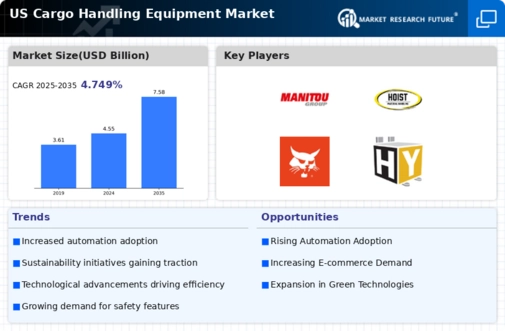Increasing Trade Activities
The cargo handling-equipment market is significantly influenced by the increasing trade activities within the United States. As trade volumes expand, the need for efficient cargo handling solutions becomes paramount. In 2025, the U.S. is expected to see a trade growth rate of around 5%, which will directly impact the demand for cargo handling equipment. Ports and warehouses are under pressure to enhance their operational capabilities to accommodate this growth. Consequently, investments in modern cargo handling technologies are likely to surge, as businesses strive to improve throughput and reduce turnaround times. This trend suggests a favorable environment for the cargo handling-equipment market, as stakeholders seek to capitalize on the growing trade landscape.
Focus on Supply Chain Resilience
The cargo handling-equipment market is increasingly influenced by the focus on supply chain resilience. In light of recent disruptions, companies are prioritizing the enhancement of their supply chains to withstand future challenges. This shift is leading to a greater investment in robust cargo handling solutions that can adapt to varying demands. In 2025, the market is anticipated to grow by approximately 5%, as businesses seek to implement flexible and scalable equipment. The emphasis on resilience is driving innovation in the industry, with companies exploring advanced technologies that facilitate rapid adjustments to changing market conditions. This trend suggests a proactive approach to supply chain management, which is likely to bolster the cargo handling-equipment market.
Technological Advancements in Equipment
The cargo handling-equipment market is experiencing a notable transformation due to rapid technological advancements. Innovations such as automated guided vehicles (AGVs) and advanced material handling systems are enhancing operational efficiency. In 2025, the market is projected to grow by approximately 8% annually, driven by the adoption of smart technologies. These advancements not only streamline processes but also reduce labor costs, making operations more cost-effective. Furthermore, the integration of IoT devices allows for real-time tracking and monitoring of cargo, which is becoming increasingly essential in logistics. As companies seek to optimize their supply chains, the demand for technologically advanced cargo handling equipment is likely to rise, indicating a robust growth trajectory for the industry.
Regulatory Compliance and Safety Standards
Stringent regulatory compliance and safety standards are increasingly shaping the cargo handling market. In the U.S., regulations governing workplace safety and environmental impact are becoming more rigorous. Companies are compelled to invest in equipment that meets these standards, which often entails upgrading to newer, safer technologies. The market is projected to grow by approximately 6% in 2025, as businesses prioritize compliance to avoid penalties and enhance operational safety. This focus on safety not only protects workers but also improves overall efficiency, as compliant equipment often features advanced safety mechanisms. Thus, adherence to regulatory requirements is likely to drive demand for innovative cargo handling solutions in the industry.
Growth of Warehousing and Distribution Centers
The cargo handling-equipment market is benefiting from the rapid growth of warehousing and distribution centers across the United States. As e-commerce continues to expand, the demand for efficient storage and distribution solutions is increasing. In 2025, the warehousing sector is expected to grow by about 7%, necessitating advanced cargo handling equipment to manage higher volumes of goods. This growth is prompting companies to invest in automated systems and high-capacity equipment to enhance their operational capabilities. The trend indicates that as more distribution centers emerge, the cargo handling-equipment market will likely experience a corresponding surge in demand, reflecting the evolving logistics landscape.















Leave a Comment